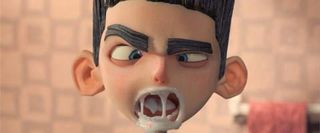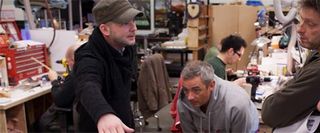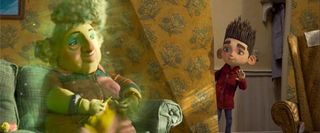ParaNorman Directors Sam Fell And Chris Butler On Why They Couldn't Make Their Movie Before Now

If you read my report from the set of ParaNorman that was posted yesterday, you know that Laika Studios is doing things unlike anyone else in the film industry. Their use of 3D printing alone – used to make replacement faces for their puppets so that they can show a variety of emotions – is groundbreaking and could end up changing the way that stop-motion animation is done. But with so much stunning technology at hand there is one big question that is raised: could ParaNorman have been made without it?
Continuing the interview that we posted yesterday with directors Sam Fell and Chris Butler, below you will find the filmmakers not only talking about the tech that went into making their new movie, but also the skill of the crew they have working with them, the calculated cost of one of the puppets, and dealing with star Kodi Smit-McPhee’s voice change.
When we were going through the costume area earlier I was looking at the amazingly tiny stiches in the clothing and I was just blown away. You’re working with this stuff every day, but do you ever get that feeling?
Sam Fell: Yeah, it’s amazing. Every now and then I’ll go on the tour myself, I just jump on the back and follow it around or I bring someone in, take them on the tour myself. Just to get out of that production mode for a moment and just look at it, it is astonishing.
Chris Butler: You talk about stitches? The stitches were designed to be asymmetrical. And sometimes I just walk around and I think, “What have I done to people?” [laughs] There are these people whose lives are spent stitching things incorrectly on purpose this big [holds up fingers very close together].
Fell: They love that!
How are they doing this by hand and having each copy match!?
CINEMABLEND NEWSLETTER
Your Daily Blend of Entertainment News
Fell: Because they’re incredibly skilled!
Butler: Incredibly skillful – and if you analyze it, it probably is. That’s part of the fabric, of having it handmade.
So you must really cherish those imperfections.
Butler: Yeah. Obviously there’s a line [laughs]. But it is definitely part of the appeal.
How long can you work with one of the puppet before it needs to go into the repair room to be mended or fixed?
Butler: It depends on the puppet and it depends on the animator.
Fell: All the animators have heavy hands on this [laughs].
Butler: Our animation supervisor has a reputation, Brad [Schiff]. I’ve worked with him on other projects, and he used to have a tally on his animation card of how many puppets he had broken [laughs].
Like notches on a gun!
Butler: Yeah. And you’ve seen the armatures…
Can you assign a value to these puppets? With all the hours and hours of resources that go into them...
Butler: A lot of money.
Fell: You could have a very nice car for one of those. Brand new. Factoring in the development – and these ones especially because our characters designs were very unusual for stop-frame animation. Very small feet, no necks, big bellies, you know…
Butler: Everything that you’re not supposed to do, basically.
Fell: Pretty much, yeah. Basically. It caused a catalogue of problems for them. Some of the characters they just had to rip up the rule book and start again and come up with some new thing. Which they did!
Butler: It’s amazing, actually. There were things that we never thought worked but we’re like, “We’ll try it anyway!” And eventually you get there.

How many main characters are there?
Butler: Lots! [laughs]
Fell: 20? There are a lot. There are seven zombies, aren’t there?
Butler: Yeah. Seven zombies, five kids in the van, there’s mom and dad and grandma, and Mr. P., Mrs. Henscher, Hooper…lots!
Who’s your favorite?
Butler: Neil.
Fell: Yeah, Neil is pretty cool. He’s our little stand-out.
He’s the breakout star?
Fell: He really is. Everyone loves him. In fact, the last recording with did with Kodi [Smit-McPhee], because when we started recording he was 11 or 12 and now he’s 14 and we still had a few lines to get and his voice had changed. The ParaNorman sequel will be in his teens [laughs].
So did you have to change it in post?
Fell: No, we were lucky, actually, we just about got everything in time.
You didn’t have to add the Chipmunks effect.
Butler: [laughs] Yeah. He was actually really good and making himself sound younger too.
Fell: He was amazing, wasn’t he?

Talking more about the technology that went into making the puppets, I’m curious if you think that this film that you’ve made could have been made before now.
Fell: I think you could have, but it would have felt smaller.
Butler: Smaller in scope, and I think you would have had to change…
Fell: You could always tell the story.
Butler: Yeah, but it wouldn’t have been… I think part of this story, the reason for making it, is that it does have some scope, it does feel like it’s a real world and it wouldn’t have felt quite so real.
Fell: I went through it. On Flushed Away I wanted to do it stop-frame but it’s like this game. Couldn’t do it. I mean, that’s a long time away now, but…
Butler: Years and years ago! [laughs]
Fell: But yeah. You couldn’t do it then, and, as I said. It’s just a number of things that all happened at once that have changed the game.
From a technological standpoint, is anyone else making this kind of movie the way you are today?
Butler: Not quite. These technologies are available around the world, so I think most people are using some of this, but from my experience this is the most complete and full on toolbox you can have.
Fell: I feel like we’re leading the charge. There’s definitely a stop-motion renascence underway at the moment, which is amazing and great. And I like to think that this studio is partly responsible for that.
Butler: With Coraline, really. It changed the game. It totally revolutionized so many things and brought it back. I mean, it was always there, there’s always been stop-frame movies ticking along, but it’s usually one at a time.
Fell: I sound like an old git now, but back in the 90s [laughs] it was over. All the stop-frame animators were like, “Yikes!” It seemed like the old medium and CG was the new thing, but it’s really turning ‘round. It’s amazing – with the color printing and the visual effects and the 3D. See, now you got the resolution…we have better resolution than a CG movie because we have real objects and real light falling on them and it’s real photography. That’s been the thing that all those CG houses have been chasing forever.
Butler: And it’s something that we find, that added element of not being able to minutely plan it, you sometimes get real surprises with our process that you weren’t expecting. Certainly some of the innovations that we’re doing haven’t been tested before, so you’re trying stuff out that’s never been done. And some of the things that come as a result of that are mind blowing, because they’re not perfect, and you would have to actually work very hard to replicate them in CG. And I think that’s what makes it really viable because we’re not trying to make things super seamless and smooth.
Fell: We couldn’t.
Butler: Nor would we want to. We want to maintain that. You know when you see a handmade costume on the screen and you see the stitches and the work that’s gone into it, there is something really tangible about that, and with the new technology we can see that stuff better, and I think that’s really exciting.

Eric Eisenberg is the Assistant Managing Editor at CinemaBlend. After graduating Boston University and earning a bachelor’s degree in journalism, he took a part-time job as a staff writer for CinemaBlend, and after six months was offered the opportunity to move to Los Angeles and take on a newly created West Coast Editor position. Over a decade later, he's continuing to advance his interests and expertise. In addition to conducting filmmaker interviews and contributing to the news and feature content of the site, Eric also oversees the Movie Reviews section, writes the the weekend box office report (published Sundays), and is the site's resident Stephen King expert. He has two King-related columns.
Most Popular




